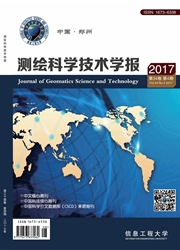

 中文摘要:
中文摘要:
地理空间信息时刻处于变化之中,道路网变化尤其明显。如何确保道路数据的现势性成为重要研究课题。每条道路往往由多条弧段组成,目前的匹配算法大多对离散弧段单独匹配,而没有把每条道路作为一个整体进行匹配,导致即使是同一条道路,往往也存在局部匹配错误的情形。本文提出了基于Stroke层次结构模型的城市道路网匹配新方法。该方法采用Stroke技术把离散的道路弧段构建为完整的道路,亦即Stroke;进一步对Stroke进行分类分级,进而构建不同层次Stroke之间的关联匹配准则;最后采取由高等级Stroke到低等级Stroke逐级匹配、并以高等级Stroke约束较低等级Stroke匹配的方法与顺序,依次完成整个道路网之间的匹配过程。该算法的优势在于:把离散的道路弧段转化为整条Stroke进行整体匹配,避免了局部因素的影响;以高等级Stroke约束较低等级Stroke匹配,层层约束,算法运算效率与匹配正确率显著提高。
 英文摘要:
英文摘要:
The geospatial data, especially road network has been in changing more and more frequently. How to maintain the currency of road network spatial data has been a significant problem. Each road always consists of some segments.The past matching algorithms mostly matched the scattered segments respectively without treating them as a whole, which always led to the partial mistake matching even if the whole road matching result might be right. A new city road network matching method based on Stroke-hierarchical model was put forward. Firstly, the scattered road fragments to be matched were constructed as integral roads, which were termed as Strokes. Secondly, the Strokes were classified, then the correlation matching principles of Strokes were constructed. Finally, the whole matching process was got by matching Strokes from high grade to low grade in order; and during the matching process, the matching results of higher grade Strokes were taken as constrains to constraint the matching of lower grade Strokes. The advantages of this method are as following: it takes the whole roads but not scattered fragments or segments as the matching objects so as to avoid the partial matching errors on one side; and the calculating efficiency and matching accuracy are improved significantly using the Stroke-hierarchical matching model on the other side.
 同期刊论文项目
同期刊论文项目
 同项目期刊论文
同项目期刊论文
 期刊信息
期刊信息
